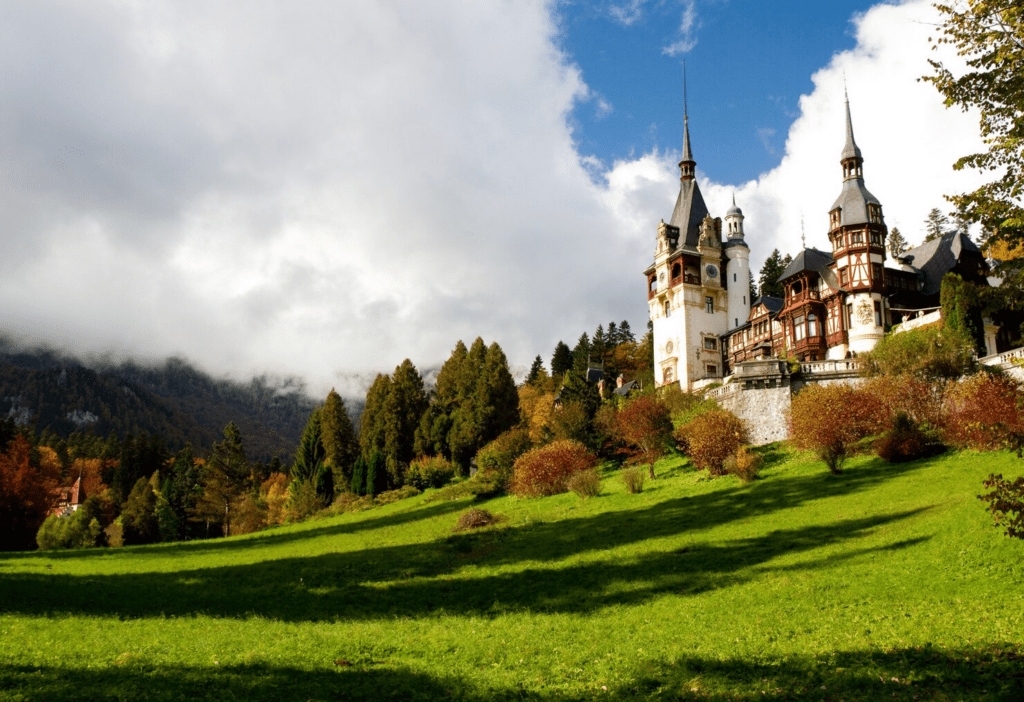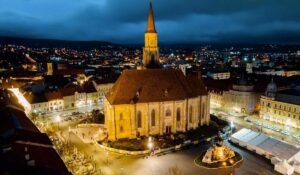Table of Contents
- 1. Introduction to Transylvania, Romania
- 2. Transylvania’s Rich Historical Tapestry
- 3. Natural Wonders of Transylvania and Romania
- 4. Medieval Transylvania: Castles, Fortresses, and Village
- 5. Transylvanian Culture and Lifestyle
- 6. Modern Transylvania: Tourism and Conservation
- 7. Exploring Transylvania’s Major Cities
- 8. Planning Your Adventure
- 9. Conclusion: Transylvania – A Mosaic of History, Nature, and Culture
- 10. Frequently Asked Questions (FAQs)
Ah, Transylvania! Just hearing that name conjures up images of misty mountains, ancient castles, and perhaps a few fanged residents. But let me assure you, there’s so much more to this enigmatic land than Dracula and spooky folklore.
Transylvania is a region rich in history, natural beauty, and diverse culture. So, fasten your seat belts—figuratively, of course—as we delve into this fascinating destination.
1. Introduction to Transylvania, Romania
What is Transylvania and Why is it a Must-Visit?
Transylvania is a historical region located in central Romania, bordered by the Carpathian Mountains. It’s a land shrouded in myth yet grounded in reality, where medieval architecture cozies up to vibrant modern cities.
Whether you’re a history buff, an adventurer, or someone who enjoys sinking their teeth (pun intended) into diverse cultures, this fairy land has something to offer. Tourism is booming here, but not in a way that taints its old-world charm.
The Significance of its Name: “Land Beyond the Forest”
The name “Transylvania” comes from Latin and literally translates to “land beyond the forest.” And, oh boy, does it live up to its name! With sprawling forests giving way to majestic mountains and quaint little villages, it really does feel like a step back in time—or perhaps into the pages of a fairy tale.
So, why is the name so fitting? Well, if you’ve ever ventured through the dense forests that lead to this charming land, you’d get it. The forests serve almost like a curtain, revealing a timeless world once you emerge from their shadow.

2. Transylvania’s Rich Historical Tapestry
The Real Story Behind Dracula and Vlad Dracula’s Legacy
Let’s tackle the bat in the room—Dracula. The fictional vampire Dracula, popularized by Bram Stoker’s novel, has somewhat eclipsed the region’s actual history.
But did you know that Stoker’s character is loosely based on a real historical figure, Vlad Dracula, also known as Vlad III or Vlad the Impaler?
A 15th-century prince, he was feared for his strict and often brutal governance, including his penchant for impaling his enemies. However, locals view him more as a hero who protected Transylvania from the Ottoman Empire.
| Dracula vs. | Vlad Dracula |
|---|---|
| Fictional vampire | Real historical figure |
| Lives in Bran Castle | Never resided in Bran Castle |
| Feeds on human blood | No evidence of vampirism |
| From Transylvania | Actually from Wallachia |

Transylvania Under Diverse Rule: Dacian Kingdom, Roman Empire, Hungarian Rule
Its history is a melting pot. Originally home to Dacian tribes, it was later conquered by the Roman Empire. The influence of Romans and Dacians still persists in the form of ruins and artifacts scattered across the region.
Post the Roman era, Transylvania was part of the Hungarian Kingdom for several centuries, which left its mark in the form of castles and traditions.
A Unique Blend of Cultures: Romanians, Hungarians, Székelys, and Saxons
Transylvania is where cultures converge. It’s home to ethnic Romanians, Hungarians, Székelys, and Saxons, among others. This rich cultural blend manifests in every facet of Transylvanian life, from architecture and cuisine to festivals and folklore.
- Romanians: The majority, bringing in Orthodox Christianity and Romanian language.
- Hungarians and Székelys: Often grouped together, they bring a unique Magyar flavor to the region.
- Saxons: German-speaking settlers who came in the Middle Ages, famous for their fortified churches.
Each community has added threads to the intricate tapestry that is modern-day Transylvania. It’s not just a land beyond the forest—it’s a land beyond simple definition.
3. Natural Wonders of Transylvania and Romania
The Majestic Carpathian Mountains and Their Biodiversity
Let’s talk mountains, specifically, the Carpathian Mountains that wrap around Transylvania like a protective cloak. A hiker’s paradise, these mountains are not just stunning to look at but are also teeming with biodiversity.
You’ll find a range of flora and fauna here that’ll make any naturalist swoon. The Carpathians are often referred to as “Europe’s last wilderness,” and once you visit, it’s not hard to see why.
Common Flora and Fauna in the Carpathian Mountains
| Flora | Fauna |
|---|---|
| Pine Trees | Brown Bears |
| Spruce | Wolves |
| Blueberries | Lynx |
| Orchids | Chamois |
Europe’s Largest Brown Bear Population
How could we explore Transylvania without mentioning its iconic brown bears? These majestic creatures constitute Europe’s largest brown bear population.
Bear tracking is a popular activity, but fear not, eco-friendly initiatives ensure that the experience is as unintrusive as possible.
Thermal Springs and Their Therapeutic Benefits
Feeling weary after all this exploration? Transylvania’s thermal springs are your go-to natural spas. Rich in minerals, these springs have been claimed to have therapeutic properties.
From ancient Dacian tribes to modern-day visitors, people have been reaping the benefits of these naturally occurring wonders.
Popular Thermal Springs in Transylvania
- Baile Tusnad: Known for its cardiovascular benefits.
- Sovata: Famous for its salty lakes and mud baths.
- Borsec: Offers a range of treatments including balneotherapy.

4. Medieval Transylvania: Castles, Fortresses, and Village
Bran Castle: Separating Dracula Myths from Reality
We’re back to Dracula, but this time to debunk some myths. Bran Castle, often marketed as “Dracula’s Castle,” is actually more tied to Romanian royalty than to Vlad the Impaler.
This stunning structure offers panoramic views of the surrounding Transylvanian landscapes and holds a rich history that spans medieval warfare, royal residence, and even a brief stint as a hospital.
Bran Castle at a Glance
| Feature | Description |
|---|---|
| Location | Near the city of Brașov |
| Built in | 14th century |
| Architectural Style | Gothic, with modern renovations |
| Must-See | The secret passage connecting the first and third floors |
The Charm of Corvin Castle and Alba Carolina
Corvin Castle is a Gothic-Renaissance marvel that looks like it leapt straight out of a storybook, complete with drawbridges and towering spires. Alba Carolina, on the other hand, is a star-shaped fortress teeming with Romanian culture and history.
The Preserved Medieval Architecture of Sibiu, Sighisoara, and Medias
Transylvania boasts some of the best-preserved medieval towns in Europe. Sibiu, Sighisoara, and Medias are must-visits.
Sibiu, with its iconic ‘eyelid’ windows, feels like it’s always watching you in the most charming way, of course. Sighisoara is the birthplace of Vlad Dracula and is almost untouched by time.
Medias is known for its leaning tower, which gives the Leaning Tower of Pisa a run for its money.
Why Visit These Towns?
- Sibiu: For the Brukenthal National Museum and the Council Tower.
- Sighisoara: For its colorful houses and the Clock Tower.
- Medias: For the St. Margaret Church and its wine culture.
- Alba Iulia: For the Alba Carolina Citadel and its rich Roman history.
Each of these destinations is a time capsule that captures.

5. Transylvanian Culture and Lifestyle
The Influence of Saxons and Their Fortified Churches
The Saxons didn’t just come to this land; they literally left their mark, mostly in the form of fortified churches.
These incredible structures, such as the Biertan Fortified Church, are more than just places of worship. They are fortresses that served as community gathering points, each telling a unique tale of the Saxon presence in Transylvania.
Notable Fortified Churches in Transylvania
| Church | Location | Unique Feature |
|---|---|---|
| Biertan Fortified Church | Biertan | UNESCO World Heritage Site |
| Prejmer Fortified Church | Prejmer | Largest fortified church in southeastern Europe |
| Viscri Fortified Church | Viscri | Supported by Prince Charles |
Traditional Transylvanian Cuisine: A Blend of Flavors and Influences
Transylvanian cuisine is as diverse as its culture, owing to the mix of Romanians, Hungarians, and Saxons who call the region home. Expect a hearty fare dominated by meats, soups, and stews, but also some surprising delicacies.
Ever heard of “Mici”? They are delicious grilled sausages, perfect for any meat lover. And let’s not forget about Palincă, the traditional fruit brandy.
Must-Try Transylvanian Dishes
- Mici: Grilled sausages
- Ciorbă de burtă: Tripe soup
- Sarmale: Cabbage rolls
- Papanasi: Sweet cheese doughnuts
Celebrating Customs, Traditions, and Festivals
Transylvania is alive with festivals that celebrate its rich history and cultural diversity. From Hungarian folk dances to Romanian Mărțișor spring celebrations, the region is a melting pot of traditions.
Whether it’s the traditional lifestyle of shepherding or the vibrant celebrations like the Sighisoara Medieval Festival, there’s never a dull moment.

6. Modern Transylvania: Tourism and Conservation
Balancing the Allure of Dracula Legends with Sustainable Tourism
As much as the legend of Dracula is a tourism magnet, there’s an increasing awareness about balancing this allure with sustainable tourism.
You’ll find several eco-tours and “green” accommodations sprouting up, aiming to protect the very essence that makes Transylvania magical.
Prince Charles’ Efforts in Promoting and Conserving Transylvania
Did you know Prince Charles is a big fan of Transylvania? He’s not only visited multiple times but also owns properties here, and has been vocal in promoting its conservation. His influence has brought international attention to Transylvania’s natural beauty and heritage.
Eco-Friendly Initiatives: Bear Tracking and Nature Preservation
Transylvania takes its wildlife seriously. Alongside traditional tourism, you can find various eco-friendly tours that aim to educate while minimizing impact. Bear tracking, for instance, is conducted under strict guidelines to ensure the magnificent creatures are not disturbed.
7. Exploring Transylvania’s Major Cities
The Vibrant Life of Cluj Napoca, Brasov, and Oradea
Okay, let’s shift gears and talk about the buzzing urban life in Transylvania. These aren’t your run-of-the-mill cities; they’re historical centers that have evolved into modern hubs.
- Cluj-Napoca: Often referred to as the ‘Silicon Valley of Eastern Europe,’ this city is a unique blend of technology and history. You’ve got to visit the St. Michael’s Church and the Cluj-Napoca Botanical Garden.
- Brasov: Nestled in the Carpathian Mountains, this city is a gateway for all kinds of mountain adventures. Don’t miss the Black Church and the Council Square.
- Oradea: Known for its Art Nouveau architecture, it’s a smaller city but packs a punch when it comes to cultural heritage. The Oradea Fortress is a must-see.
Language and Culture: The Blend of Romanian, Hungarian, and German
Transylvania is a polyglot’s dream. Romanian is the official language, but don’t be surprised to hear Hungarian, German, and even some Romani. This mix gives the cities a cosmopolitan feel while still rooted deeply in Transylvanian history and heritage.

8. Planning Your Adventure
Best Time to Visit Transylvania and Recommended Duration
Wondering when to pack your bags? Ideally, aim for late spring to early autumn. The weather is just perfect – not too hot, not too cold.
As for how long you should stay, that depends on your interests. But a week should give you a good taste of what Transylvania offers.
Seasonal Highlights in Transylvania
| Season | Best For |
|---|---|
| Spring | Wildflower blooms, hiking |
| Summer | Festivals, castle tours |
| Autumn | Fall foliage, wildlife spotting |
| Winter | Skiing, winter sports |
Getting to Transylvania: Airports, Trains, and Road Routes
Transylvania is more accessible than you might think. Major cities like Cluj-Napoca and Brasov are well-connected by air, train, and road.
Getting to Transylvania: A Quick Guide
| Mode | Best For | Notes |
|---|---|---|
| Air | Quick and Convenient | International airports in Cluj-Napoca and Sibiu |
| Train | Scenic Journeys | Direct routes from Bucharest and other major cities |
| Road | Flexibility and Adventure | Well-maintained roads; car rentals readily available |
Handpicked Tours and Experiences for an Authentic Journey
If planning isn’t your strong suit, worry not! There are plenty of organized tours that can give you an authentic Transylvanian experience.
Whether it’s bear tracking in the Carpathian Mountains or a deep dive into the history of Bran Castle, there’s something for everyone.
Popular Tours in Transylvania
- Haunted Transylvania: A tour dedicated to the Dracula legend.
- Culinary Transylvania: Explore the regional cuisine in a cooking class.
- Castle Hopping: Visit multiple castles in a single tour.
9. Conclusion: Transylvania – A Mosaic of History, Nature, and Culture
By now, you probably get the picture: Transylvania is a whole lot more than spooky castles and mythical vampires. It’s a diverse and enchanting region where history, nature, and culture come together in a mesmerizing blend.
Whether you’re hiking in the Carpathian Mountains, savoring the traditional Palincă, or exploring the Saxon heritage through fortified churches, Transylvania never ceases to amaze.
Reflecting on the Unique Charm and Allure of Transylvania
The magnetic allure of Transylvania lies in its diversity. This isn’t a one-note travel destination; it’s a multifaceted jewel with many sides to explore.
Whether it’s the history of Vlad Dracula and the Dacian Kingdom, or the modern influences of technology in cities like Cluj-Napoca, Transylvania keeps you on your toes.
So, if you’re still on the fence about visiting, hop off it! This is one destination that will exceed your expectations.
Encouraging Readers to Explore and Respect the Region’s Heritage
As travelers, it’s crucial that we respect the places we visit. Transylvania’s rich cultural tapestry and biodiversity are treasures that deserve our mindful exploration.
The very essence of the region—its history, its legends, its natural beauty—relies on sustainable tourism and conservation efforts.
10. Frequently Asked Questions (FAQs)
Is Transylvania Safe for Tourists?
Safety is always a concern, right? Well, good news: Transylvania is generally considered safe for tourists. Just exercise the usual precautions – keep an eye on your belongings, be mindful of your surroundings, and you’ll be just fine.
How is Transylvanian Cuisine Different from Other Romanian Cuisines?
Its cuisine is a mouth-watering mishmash of Romanian, Hungarian, and Saxon influences. While you’ll find similarities to broader Romanian cuisine, like Mici and Sarmale, Transylvanian dishes often come with a unique twist, be it in the spices or preparation methods.
What Are the Top ‘Must-See’ Sights of Transylvania?
Ah, the million-dollar question. But if we have to narrow it down:
- Bran Castle: Because, come on, it’s Dracula’s Castle!
- Carpathian Mountains: For the sheer natural beauty and biodiversity.
- Sibiu: For its preserved medieval charm.
There you go! This is your all-in-one guide to Transylvania, touching on everything from its deep-rooted history to modern-day tourism.
Whether you’re a history buff, a nature enthusiast, or simply a curious traveler, Transylvania has something to offer you.
So, when are you planning your Transylvanian adventure?







